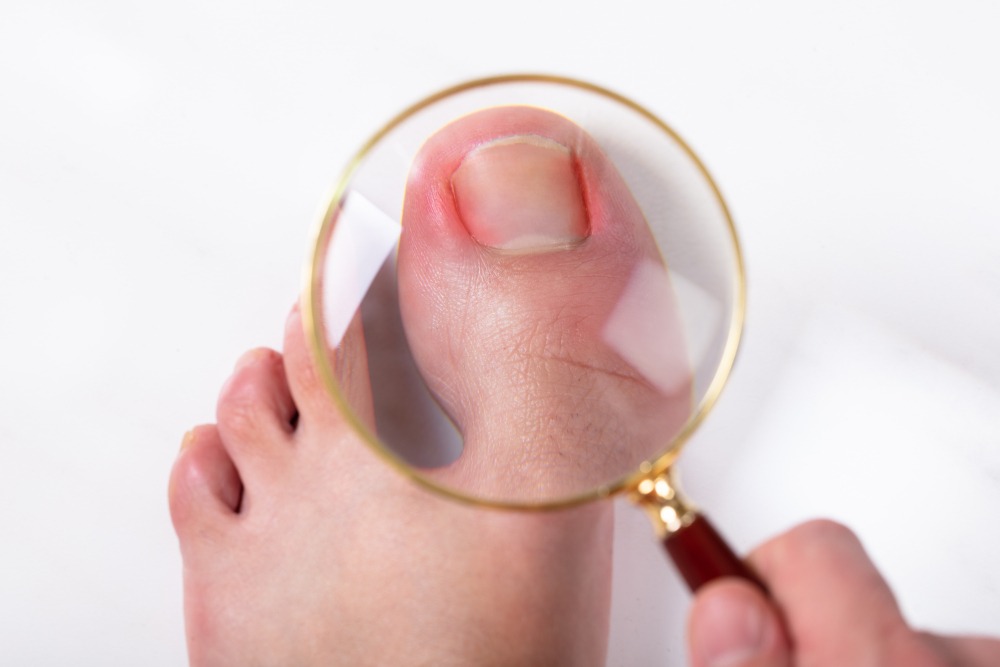
Onychocryptosis (the ingrown toenail medical term) is a common and sometimes painful condition experienced when a toenail grows into the surrounding flesh. Understanding the factors that contribute to its development can help prevent it. However, when the pain becomes unbearable, you’ll need to visit a foot health professional. This article outlines the condition’s symptoms and causes while providing insight into how to treat an ingrown toenail.
What is an ingrown toenail?
Onychocryptosis is a common infection caused by skin growing over the toenail. This condition typically affects the big toe, especially if the nail is cut too short. Although it can occur in people of all ages, it’s most common in teenagers and older people. While ingrown nails are usually benign, they can become problematic if the infection spreads or the affected person has underlying health issues. In such cases, it’s recommended to schedule a visit with a chiropodist.
Are ingrown toenails common?
In Canada, approximately two out of every ten visits to foot-care clinics are related to nail issues. Fortunately, many nail problems can be easily treated by a healthcare professional.
Ingrown toenail causes
Ingrown nails can be caused by various factors, such as cutting the nail too short or rounding it at the edges. Tight shoes can also exert pressure on the nails, leading to deformities, while soft skin is more susceptible to nail penetration. Excessive sweating can further increase the risk of ingrown toenails and infection, as moist feet in enclosed shoes create a favourable environment for bacterial growth.
It’s crucial to practice good hygiene to prevent complications. This is especially true for people with diabetes—their weakened immune systems make them more vulnerable to infected ingrown toenails. Additionally, poor hygiene can slow down the healing process, increasing the likelihood of ulcers.
Who is most at risk of getting an ingrown toenail?
Hyperhidrosis (abnormal sweating of the feet) and poor foot hygiene increase the risk of developing ingrown toenails. Repeated trauma to the foot can also weaken the nail and make it more prone to ingrowth. Additionally, foot deformities such as bunions (hallux valgus), which reduce shoe space for the toe, can lead to poor nail growth.
Signs of an ingrown toenail
In minor cases, signs of an ingrown toenail are often subtle, and the skin growing over the toenail may only be mildly painful. This type of manifestation usually disappears on its own if proper foot hygiene is maintained. However, in more advanced stages, the affected skin may become red, swollen, and increasingly painful, with a warm sensation. The skin around the nail may appear visibly swollen and may contain pus or blood. People with diabetes are particularly vulnerable and may develop sores or ulcers.
If left untreated, an ingrown toenail can lead to bone and toenail infections (toenail fungus) and cause significant pain, making it difficult to bear weight on the affected foot. In such cases, it’s best to schedule a consultation with a chiropodist as soon as possible.
Assessing an ingrown toenail
During an ingrown toenail consultation, the chiropodist visually examines the foot and may take a swab if the patient’s medical history suggests a link to a disease. This analysis helps identify the root cause of the problem and ensures effective treatment. Sometimes, the chiropodist may refer the patient to a medical imaging specialist for X-rays to rule out possible bone problems. With this information, the chiropodist can develop an appropriate treatment plan.
How to treat an ingrown toenail
A visit to the clinic can help alleviate pain, treat the wound, and prevent the ingrown toenail from recurring. The chiropodist may suggest various ingrown toenail treatments based on the severity of the condition. Trimming the nail to ensure proper growth is a common option, along with applying antibiotic cream to reduce inflammation and heal the infected ingrown toenail. For correcting the nail’s shape, a special orthosis can be used. In severe cases, a matrixectomy surgery can remove the nail, burn the ingrown part, and prevent future occurrences. The chiropodist will discuss all ingrown toenail treatments with the patient and recommend the most suitable.
What’s the recovery time?
The healing time of an ingrown toenail depends on the stage of the condition. A non-infected nail may heal within a few days, but if the toenail has penetrated deep into the skin and caused an infection, it may take several weeks for the nail to return to its normal state.
Are there treatment contradictions?
There are no strict treatment contraindications for ingrown toenails. Nevertheless, informing your healthcare professional of your medical history and any hereditary or congenital conditions is vital.
Ways to prevent ingrown toenails
Good foot hygiene and straight nail clipping prevent ingrown toenails. These practices can protect the foot from infection and encourage proper nail growth. Additionally, selecting footwear that fits well and is made from breathable materials can be beneficial. Choosing shoes that do not compress the feet can help prevent ingrown toenails and keep the feet healthy.
Visit a chiropodist to maintain healthy toenails
When it comes to foot health, our toenails require care and attention, just like our joints and muscles. Good hygiene, appropriate shoes, and straight nail clipping are all effective ways to prevent ingrown toenails and infection. For more tips, your chiropodist is an endless well of knowledge. Podiatric or Chiropodist checkups are great opportunities to receive practical home foot-care advice. Scheduling a visit to your local clinic is a proactive way to maintain healthy feet.

